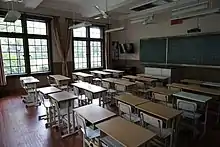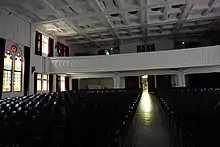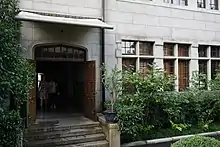Shanghai No. 3 Girls' High School
Shanghai No. 3 Girls' High School (Chinese: 上海市第三女子中学) is a key public all-female high school in Shanghai, China. The predecessors of the school were St. Mary's Hall, established in 1881, and McTyeire School, established in 1892.
| Shanghai No. 3 Girls' High School 上海市第三女子中学 | |
|---|---|
 | |
| Address | |

| |
155 Jiangsu Road , China | |
| Information | |
| Type | Public |
| Motto | I(Independent Chinese: 独立),A(Ability Chinese: 能干),C(Care Chinese: 关爱),E(Elegant Chinese: 优雅) |
| Established | 1892 |
| Principal | Xu Yongchu (徐永初) |
| Faculty | 110 |
| Gender | All-Female |
| Enrollment | over 1100 |
| Campus | 53,360 square metres (13.19 acres) |
| Website | www |
| Shanghai No. 3 Girls' High School | |||||||||
|---|---|---|---|---|---|---|---|---|---|
| Simplified Chinese | 上海市第三女子中学 | ||||||||
| Traditional Chinese | 上海市第三女子中学 | ||||||||
| |||||||||
In 1952, these two schools were taken over by the People's Government of Shanghai and merged into "Shanghai No. 3 Girls' High School".








Heidi Ross, author of "Historical Memory, Community Service, Hope: Reclaiming the Social Purposes of Education for the Shanghai McTyeire Schools for Girls," noted that McTyeire had a reputation for being elitist and privileged.[1] She added that the school provided a sense of stability and isolation from problems during World War II.[2]
Location
The campus is located on 155 Jiangsu Road, Changning District, Shanghai, China. The campus covers 80 mu or about 53360 m².
Alumnae
Famous alumnae of the school and its predecessors include Soong Ching-ling, wife of President Sun Yat-sen, Soong Mei-ling, wife of Chiang Kai-shek, Soong Ai-ling, wife of Kung Hsiang-hsi, and Eileen Chang, one of the most influential modern Chinese writers. Businesswoman Rosalyn Chin-Ming Chen was educated here.
Education aim
Shanghai No. 3 Girls' High School aims to train students to be "IACE girls", in which "IACE" means "Independence, ability, care, elegance". The school uses this motto based on several aspects. First, it aims at the distinguishing feature of girls' growth. "I" and "A" are to require girls to improve their shortcomings and "C" and "E" require girls to show their advantages. Second, these four aspects completely embody the features that modern outstanding female talent have.
Independence
- Having a strong ability to be independent; can study alone and manage one's own living; can think independently and critically; can make a brilliant choice.
Ability
- Having a strong confidence; being strong-willed; having a strong ability in study, working and life; being good at communicating and cooperating with others.
Care
- Caring for others, team, nature, country and society; Having strong responsibility and capability to take action.
Elegance
- Having a high moral character; being elegant and courteous.
In addition, the educational model of Shanghai No. 3 Girls' High School is quality education rather examination-oriented education. To improve students' capacity across disciplines, there is much practical curriculum opening as selective courses, such as the art of tea, western table manners, and the baking class.
Administration
Principal
- Xu,YongChu (徐永初)
Academics
Every year, a massive number of outstanding students graduate from Shanghai No.3 Girls' High School and attend the most elite universities in China either Peking University, Tsinghua University, Fudan University, Jiao Tong University or Tongji University. A group of students win prizes in many kinds of high-level contests annually. In 2005, 300 graduates of Shanghai No.3 Girls' High School have attended top universities either Peking University, Tsinghua University, Fudan University or Jiao Tong University.
External links
References
- Ross, Heidi. "Historical Memory, Community Service, Hope: Reclaiming the Social Purposes of Education for the Shanghai McTyeire Schools for Girls." In: Peterson, Glen, Ruth Hayhoe, and Yongling Lu (editors). Education, Culture, and Identity in Twentieth-century China. The University of Michigan Press, 2001. ISBN 0472111515, 9780472111510. Start: p. 375.